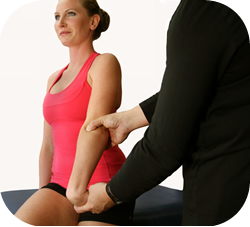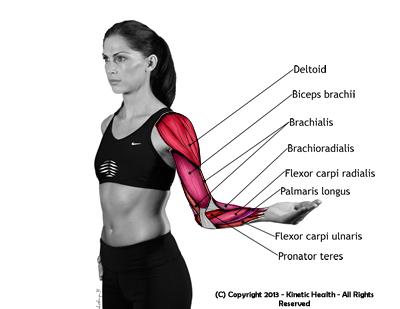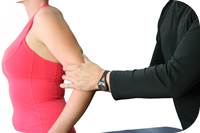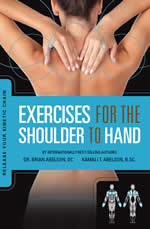Resolving Golfer’s Elbow
Golfer’s Elbow (Medial Epicondylitis) refers to the pain and inflammation that occurs at the inside point of the elbow (medial  epicondyle). Golfer’s Elbow can be caused by any activity (not just golf) that requires forceful and repeated bending of the wrist and fingers.
epicondyle). Golfer’s Elbow can be caused by any activity (not just golf) that requires forceful and repeated bending of the wrist and fingers.
Symptoms of Golfer’s Elbow
Many patients who come to our clinic suffering from Golfer’s Elbow, also show these other common problems:
- Rounded shoulders (anterior posture).
- Restriction in the neck and low back (hypertonic or tight muscles with numerous trigger points).
- Tight restricted hips which are causing abnormal motion patterns.
- Poor balance.
Click on each of the following tabs for more information about how we work with you to heal your elbow injury.
- Causes of Golfer’s Elbow
- The Kinetic Chain of Golfer’s Elbow
- Treating Golfer’s Elbow
- A Patient’s Story
Causes of Golfer’s Elbow
When a Golfer swings his club, the flexor muscles and tendons of the arm tighten just before the club makes contact with the ball. This repeated action stresses the muscles, causing micro- tearing of the flexor tendon, and inflammation of the soft tissues. RSI problems occur when these muscles and tendons continue to be re-injured while the small tears are still in the process of healing. These new injuries cause the body to lay down additional adhesive scar tissue between the muscle layers in an attempt to stabilize the affected soft tissues.
This repeated action stresses the muscles, causing micro- tearing of the flexor tendon, and inflammation of the soft tissues. RSI problems occur when these muscles and tendons continue to be re-injured while the small tears are still in the process of healing. These new injuries cause the body to lay down additional adhesive scar tissue between the muscle layers in an attempt to stabilize the affected soft tissues.
This scar tissue forms attachments to adjacent layers of tissue and structures, and inhibits the normal movement or translation of these soft-tissue structures. This lack of smooth movement causes friction and generates an ongoing cycle of inflammation and scar tissue formation.
The Kinetic Chain of Golfer’s Elbow
 The game of golf emphasizes one-sided activity of the body; you are either a right-handed golfer or a left-handed golfer. This unilateral focus is the cause of numerous injuries as golfers tend to develop muscle imbalances which cause a wide array of myofascial restrictions.
The game of golf emphasizes one-sided activity of the body; you are either a right-handed golfer or a left-handed golfer. This unilateral focus is the cause of numerous injuries as golfers tend to develop muscle imbalances which cause a wide array of myofascial restrictions.
Golf, in its ideal form, is all about efficiently storing and releasing energy from your core out into your extremities. The classic golf swing engages your entire kinetic chain from your feet – which form a solid stance – up through your hips and core, to finally release energy through your shoulders and arms right into the club head. This is much like a coiled spring, storing energy, then suddenly releasing it.
Unfortunately, for most golfers, this “coiled spring” is either broken or functions only minimally. Many golfers find that in the game of Golf, much of their energy and focus is spent on learning how to compensate for muscle imbalances, poor posture, and the multitude of myofascial restrictions that have developed over time.
Treating Golfer’s Elbow with ART
Elbow injuries such as Tennis Elbow and Golfer’s Elbow often require the practitioner to address a much larger area than just the elbow area. Symptomatically, something that initially appears to be an elbow injury, may actually be the result of poor core stability and lack of strength. This requires treatment of a much larger kinetic chain than just the elbow region.
elbow area. Symptomatically, something that initially appears to be an elbow injury, may actually be the result of poor core stability and lack of strength. This requires treatment of a much larger kinetic chain than just the elbow region.
It is important to treat the entire kinetic chain for an elbow injury. Not just the point of pain! In order to effectively balance your muscles and remove joint restrictions we conduct a biomechanical analysis to identify your unique pattern of muscle imbalances. By utilizing a series of muscle balance and motion analysis tests, we can identify the exact type, extent, and location of soft-tissue restrictions.
We then use soft-tissue treatments and follow-up exercises to release and resolve these restrictions, and then strengthen the muscles to prevent re-injury.
With this type of treatment perspective, we look beyond just the symptomatic areas, and also consider the effect that other soft-tissue structures within the elbow’s kinetic chain have upon the injury. These areas can include restrictions in structures ranging from the neck to the wrist.
We are able to achieve a very high level of success in treating these conditions simply because we identify and remove all the multiple levels of restrictions that inhibit the translation and movement of soft-tissues in these areas.
More Information about Golfer’s Elbow
Dr. Abelson provides a broad range of information to his patients and the public. They range from published books (eBook and hard-copy), to blogs, exercises YouTube Videos, websites, and articles. Click on the following tabs to access some of his more popular information resources for Golfer’s Elbow.
Books for Resolving Golfer’s Elbow
Both these books provide exercise routines designed to reactivate your kinetic chain and your neuromuscular system. Use these as tools to resolve your Frozen Shoulder.
Release Your Pain: 2nd Edition
Dr.Abelson’s international best-seller – Release Your Pain – provides a detailed description about the causes of Golfer’s Elbow and other elbow injuries. It discusses means for resolving this condition, and provides specially selected exercises to help you begin the process of healing from this condition.
Visit our website at www.releaseyourbody.com to purchase your eBook or hard-copy.
 Release Your Kinetic Chain: Exercises for the Shoulder to Hand
Release Your Kinetic Chain: Exercises for the Shoulder to Hand
The phased exercise routines in Exercises for the Shoulder to Hand are designed to build and strengthen the neuromuscular relationships in the structures from your hand to shoulders and core. These exercises are a critical component of any treatment plan for the resolution of elbow injuries. Visit our website at www.releaseyourbody.com to purchase your eBook or hard-copy.
Exercise Videos for Golfer’s Elbow
The following videos provide extra information about Golfer’s Elbow and the kinetic chain, as well as exercises to help resolve this elbow injury. Click on the left and right arrows to scroll through our Golfer’s Elbow videos.
- Foam Roller for the Forearms
- Click To PlayPlay Video
The foam roller is a great tool you use to help resolve Golfers Elbow.
- Nerve Flossing – Waiters Tip Exercise
- Click To PlayPlay Video
This exercise will help you floss the nerves from your neck, shoulder, elbow, and wrist.
- Ulnar Nerve Flossing
- Click To PlayPlay Video
If you have Ulnar nerve entrapment syndrome use the exercises in this video to floss, mobilize, and release this nerve from its surrounding tissues.
Blog Articles by Dr. Brian Abelson
Click on the following blog articles for additional information on Golfer’s Elbow and other elbow injuries. Treating Golfer’s and Tennis Elbow with Active Release
Treating Golfer’s and Tennis Elbow with Active Release
Golfer’s Elbow (Medial Epicondylitis) refers to the pain and inflammation that occurs at the inside point of the elbow (medial epicondylitis).
Golfer’s Elbow can be caused by any activity (not just golf) that requires forceful and repeated bending of the wrist and fingers. For example: when the golfer swings his club, the flexor muscles and tendons of the arm tighten just before the club makes contact with the ball.
Golfer’s Elbow and the Kinetic Chain
 There is a much bigger picture that needs to be addressed in resolving elbow injuries, which is commonly missed. For example what symptomatically appears as an elbow injury can start as a lack of core stability, which involves a much larger kinetic chain.
There is a much bigger picture that needs to be addressed in resolving elbow injuries, which is commonly missed. For example what symptomatically appears as an elbow injury can start as a lack of core stability, which involves a much larger kinetic chain.
The game of golf only emphasizes one side of the body; either you are a right-handed golfer or a left-hander golfer. This unilateral focus is the cause of numerous injuries. Because the game of golf emphasizes just one side of the body most golfers develop muscle imbalances and a wide array of myofascial restrictions.
For more information about our clinic in Calgary, Alberta, please visit www.kinetichealth.ca.
(COPYRIGHT KINETIC HEALTH 2013 – ALL RIGHTS RESERVED)

